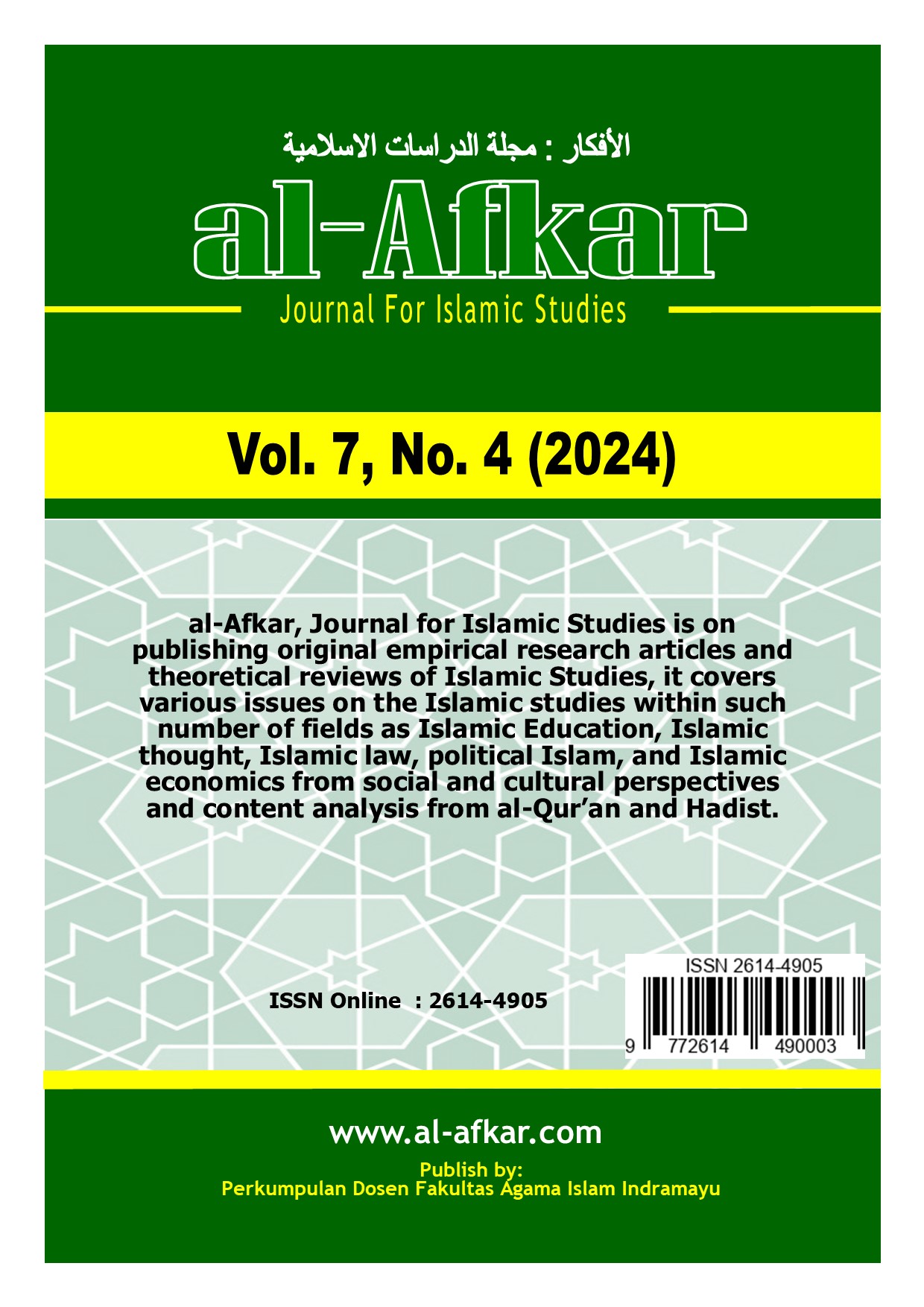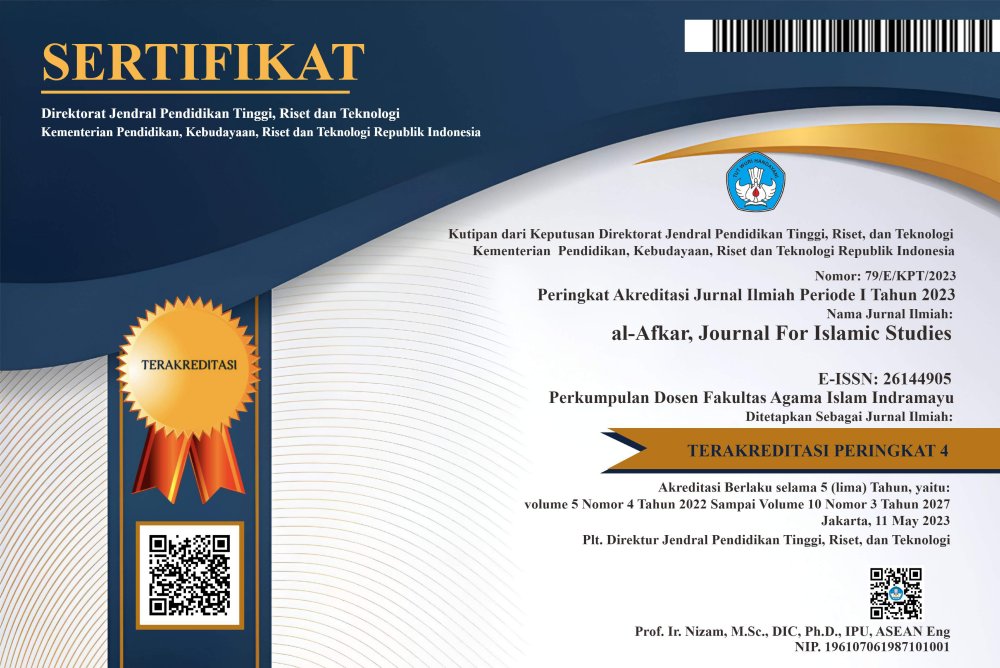Jin in Surah Al Jin Verses 1-7 (Comparative Study of Tafsir Kemenag and Quraish Shihab)
DOI:
https://doi.org/10.31943/afkarjournal.v7i4.1167Keywords:
Jin, Surah Al-Jin Verses 1-7, Tafsir Kemenag Agama (Kemenag RI), Tafsir Quraish ShihabAbstract
Jinns are invisible beings created by God. This is one of those beings favored by the Qur'an. But the existence of jinns will always be the subject of research and attention of every circle, just like the existence of humans themselves. Besides the fact that the existence of jinns predates humans, jinns are controversial figures both among laypeople and even among scholars. But there are still many people who wonder whether jinns exist, whether humans can see them, and what are the characteristics of life? Because in the Quran, the word jinn is mentioned 34 times. This is the article that requires humans and especially Muslims to know detailed information about the existence of jinns. From there the author tries to explain simply how the Qur'an, especially in Sura Al-Jin verses 1-7 views jinns. But in this article the author will only focus on the perception of tafsir scholars, namely Tafir Ministry of Religious Affairs and Tafsir Quraish Shihab. The systematics of writing this article includes using thematic methods or maudui, namely by searching for keywords in mufradat, then analyzing the relationship between verses and comparing different verses. The author concludes tentatively that jinns were created from fire just as humans were created from the ground. Jinns are bukallaf beings like humans and in the here after they will be rewarded for all their deeds. This is why humans and jinns are called ats-tsaqalain. In today's life, genius is also understood as a virus, a type of negative human potential. They have extraordinary abilities that humans cannot perform, meaning that they do not mean that humans are inferior to jinns but according to the functions they create. In the world of jinns, there are people who are shaleh but many are evil and even unfaithful. God's purpose in creating Jinns was not just to worship and become His servants.
Downloads
References
Ahmad, N. Al-Tarjih fi Al-Tafsir: antara Makna Al-Qur’an dan Tindakan Manusia. (n.d.-b). https://scholar.google.com/citations?view_op=view_citation&hl=id&user=lsGwJwwAAAAJ &citation_for_view=lsGwJwwAAAAJ:9yKSN-GCB0IC
Ahmad, N. (2021, June 4). THE MEANING OF KAFIR IN TAFSIR MUHAMMADIYAH: A COMPARATIVE ANALYSIS STUDY. Ahmad | Prophetics: Journal of Islamic Studies. https://journals.ums.ac.id/index.php/profetika/article/view/14774
Ariyanto, M. D. (2007, May 1). RUQYAH THERAPY AGAINST PHYSICAL, MENTAL ILLNESS AND JINN DISORDERS. https://publikasiilmiah.ums.ac.id/handle/11617/901
Al-Suyuthi, Imam Jalaluddin, Uncovering the Mysteries of the Occult, Bogor: Kanza Publishing, 2011
As-Suyuthi, Imam Jalaluddin. Mysteries of the Unseen. Jakarta: Kanza Publishing, 2011
Z. Abdussamad, Qualitative Research Methods, Print I. Makassar: Syakir Media Press, 2021.
Darusmanwiati, Aep Saepuloh. The Smart Book of the Occult Realm Series II (The Jinn and Satanic Realm) according to the instructions of the Qur'an and Sunnah. tt: Indonesianschool.org, tth.
Dawud, Muhammad Isa. Dialogue with Muslim Jinns. Bandung: Pustaka Hidayah, 1995
H. A. Said and N. Ferdiani, "Methodology of the Qur 'an and Its Tafsir By the Ministry," Stud. Islam., Vol. 20, No. 1, pp. 1–29, 2022.
HUMANIKA, vol. 21, no. 1, pp. 33–54, Apr. 2021, doi: 10.21831/hum.v21i1.38075.
Hz, S. (2010, May 1). JINN IN THE PERSPECTIVE OF THE QUR'AN AND HADITH. https://publikasiilmiah.ums.ac.id/handle/11617/2245
Jin - Wikipedia Indonesian, the free encyclopedia. (2023, December 1). https://id.wikipedia.org/wiki/Jin
M.A. Ashharie, et al., Mysteries of the Astral World (tt., Vision 7 Publishers, 2013), p.142
M.A. Ashharie, et al, Mysteries of the Astral World, Uncovering the Life of Angels and Jinns According to Guidance in Islam.p.143.
M. Esa Prasastia Amnesti, "Characteristics of The Qur'an Interpretation and Their Team Work of The Ministry of Religion of The Republic of Indonesia Muhammad Esa Prasastia Amnesti," Ascarya, vol. 1, no. 2, pp. 93–110, 2021, [Online]. Available: https://doi.org/10.53754/iscs.v1i2.18
Ministry of Religious Affairs of the Republic of Indonesia, THE QUR'AN AND ITS TAFSEER, vol. VIII. Jakarta: Widya Cahaya, 2011.
M. R. Fadli, "Understanding the design of qualitative research methods,"
Qisthi, Aqis bil. Unveiling the Existence of Two Ghoib Beings, Angels and Jinns. Surabaya: Mulia Jaya, 2006.
Munazir, Jinn's Position as a Subject of Islamic Law (IAIN Serang: Master's Thesis in Islamic Family Law, 2013), p.39.
M. Q. Shihab, TAFSIR AL-MISHBAH Message, Impression and Compatibility of the Qur'an, vol. 14. Tangerang: Lentera Hati Publishers, 2005.
M.Quraish Shihab, Jinn in the Subtle and Invisible Qur'an, p. 146.
M. Quraish Shihab, The Jinn in the subtle and invisible Qur'an, p.144
Nur, A. (2012, June 1). M. Quraish Shihab and the Rationalization of Tafsir. Nur | Ushuluddin Journal. https://ejournal.uin- suska.ac.id/index.php/ushuludin/article/view/696/647
Nurrohim, A. (2020, January 17). ḤIKMAH IN THE QUR'AN: A THEMATIC STUDY OF TAFSIR AL-MIZĀN. Nurrohim | Prophetics: Journal of Islamic Studies. https://journals.ums.ac.id/index.php/profetika/article/view/9954
R. Igisani, "Study of Tafsir Mufassir in Indonesia," Portrait of a Thinker., Vol. 22, No. 1, 2018, DOI: 10.30984/PP.V22I1.757.
Wartini, A. (2014). THE STYLE OF INTERPRETATION OF M. QURAISH SHIHAB IN TAFSIR AL-MISBAH. Hunafa: Journal of Critical-Analytical Islamic Thought, 11(1), 109. https://doi.org/10.24239/jsi.v11i1.343.109-126
Downloads
Published
How to Cite
Issue
Section
License
Copyright (c) 2024 Feryyanto Bayu Syahniar, Ahmad Nurrrohim, Abdullah Mahmud

This work is licensed under a Creative Commons Attribution 4.0 International License.



















